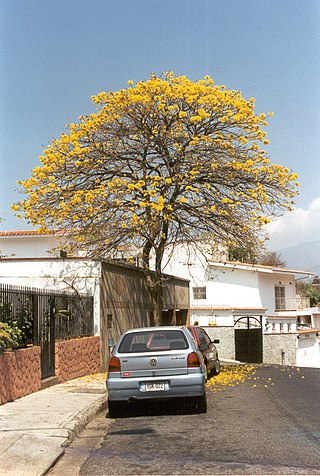
Caracas, officially Santiago de León de Caracas (CCS), is the capital and largest city of Venezuela, and the center of the Metropolitan Region of Caracas. Caracas is located along the Guaire River in the northern part of the country, within the Caracas Valley of the Venezuelan coastal mountain range. The valley is close to the Caribbean Sea, separated from the coast by a steep 2,200-meter-high (7,200 ft) mountain range, Cerro El Ávila; to the south there are more hills and mountains. The Metropolitan Region of Caracas has an estimated population of almost 5 million inhabitants.

Miranda State is one of the 23 states of Venezuela and the second most populous after Zulia State. As of the 2011 census, it had a population of 2,675,165 residents. It also has the greatest Human Development Index in Venezuela, according to the Venezuelan National Institute of Statistics. The most recent population estimate was 3,194,390 in mid-2016.

The Caracas Metro is a mass rapid transit system serving Caracas, Venezuela. It was constructed and is operated by Compañía Anónima Metro de Caracas, a government-owned company that was founded in 1977 by José González-Lander who headed the project for more than thirty years since the early planning stages in the 1960s. Its motto is "Somos parte de tu vida". In 1978 MTA – New York City Transit's R46 #816 was shipped from the Pullman Standard's plant as a sample of rolling stock to be used for the new metro system that was under construction at the time.

The following is an alphabetical list of topics related to Venezuela.

The Ávila National Park, officially known as Waraira Repano National Park for its indigenous Cariban name, protects part of the Cordillera de la Costa Central mountain range, in the coastal region of central-northern Venezuela. The area's highest elevation is Pico Naiguatá, at 2,765 meters (9,072 ft) above sea level.

Guarenas is a city in Miranda, Venezuela. It was established in 1621 as Nuestra Señora de Copacabana de los Guarenas. It is part of the Guarenas-Guatire conurbation
TV Familia is a Caracas based regional familiar, entertainment, religious and cultural television network. It can be seen by those only living in greater Caracas on UHF channel 69. It can also be seen on Directv channel 117, Net Uno (8), Intercable (79) in Caracas, Guarenas, Guatire, and the Vargas State, and Sistemcable (4).

Guatire is a city in Miranda, Venezuela. In 2006, its population has been estimated at 200,417. Today, Guatire has virtually merged with its neighbour, Guarenas forming the Guarenas-Guatire conurbation.

Zamora is one of the 21 municipalities (municipios) that makes up the Venezuelan state of Miranda and, according to a 2011 population estimate by the National Institute of Statistics of Venezuela, the municipality has a population of 187,075. The town of Guatire is the municipal seat of the Zamora Municipality.

Dulce Nombre de Jesús de Petare is a neighborhood in Miranda, Venezuela, and is part of the Metropolitan District of Caracas. It is located in the Sucre Municipality, one of the five divisions of Caracas. The city was founded in 1621 under the name of San Jose de Guanarito. It grew to become a part of the Greater Caracas area as the latter expanded in area and population. Petare had a population of 372,106 inhabitants and about 448,861 according to 2020 estimates. Petare is the biggest slum in Venezuela, and in South America.
Guarenas / Guatire Metro is a combined metro/light rail project of the Caracas Metro to connect the twin cities of the Guarenas-Guatire conurbation and intermediate communities to Caracas, Venezuela.

The Caracas Metrobus is a public transit system in Venezuela. The bus network consists of 20 urban and 4 suburban routes which connect to the nearby cities of Los Teques, Guarenas, Guatire and San Antonio de Los Altos. At present, it consists of a fleet of 220 buses.

Handroanthus chrysanthus, formerly classified as Tabebuia chrysantha, also known as araguaney in Venezuela, as guayacán in Colombia and Panama, as chonta quiru in Peru, and Ecuador, as tajibo in Bolivia, and as ipê-amarelo in Brazil, is a native tree of the intertropical broadleaf deciduous forests of South America above the Tropic of Capricorn. On May 29, 1948, Handroanthus chrysanthus was declared the National Tree of Venezuela due to its status as an emblematic native species of extraordinary beauty. Its deep yellow resembles that of the Venezuelan flag.
Plaza is one of the 21 municipalities (municipios) that makes up the Venezuelan state of Miranda and, according to a 2016 population estimate by the National Institute of Statistics of Venezuela, the municipality has a population of 238,750. The city of Guarenas is the administrative centre of the Plaza Municipality.

The Metrocable de Caracas is a gondola lift system integrated with the city's public transport network, which provides quick and safe transportation for those who live in the neighbourhoods situated on Caracas's mountainous regions. The system was built as a tool for social reform with stations set up to accommodate a variety of services such as daycares, libraries, police stations, markets and theatres.

Guarenas-Guatire conurbation or Guarenas-Guatire metropolitan area , also known as El Nuevo Este de Caracas, is a conurbation area in Miranda, Venezuela, that includes 2 municipalities, it is part of the Greater Caracas Area. It has a population of approximately 488,000 inhabitants.
Guarenas-Guatire may refer to:
The 1900 Venezuelan earthquake, occurred on October 28 at between 4:30 and 4:45 am local time. This earthquake had an epicenter off Miranda State or near the Venezuelan capital Caracas, in the Cariaco Basin. It had an estimated moment magnitude of 7.6–7.7 and a surface-wave magnitude of 7.7–8.4. It had a maximum Mercalli intensity assigned VIII–X, causing landslides and liquefaction events. Many buildings were severely damaged or collapsed during the earthquake. It is thought to be the last great earthquake of the 19th century and the largest instrumentally recorded in the republic, having been felt throughout.











